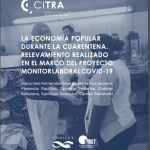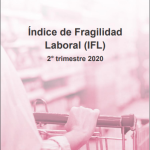Método CITRA Vol. 6
La protesta en cuarentena. Análisis de una base cuantitativa sobre protestas sociales en el marco del proyecto Monitor laboral
NOVIEMBRE 2020 | ISSN 2618-351X
El Aislamiento Social, Preventivo y Obligatorio (ASPO) dispuesto por el gobierno nacional a propósito de la declaración de la pandemia provocada por el virus SARSCoV-2 de la familia de los coronavirus aparejó el aislamiento de la población, pero también el reordenamiento de la economía entre actividades esenciales y no esenciales con los consecuentes efectos negativos sobre la economía. Las previsiones de los gobiernos, organismos multilaterales, empresarios y sindicatos preveían un escenario catastrófico para el mundo del trabajo y sus trabajadores. En este contexto, a finales de marzo desde el CITRA/UMET impulsamos el proyecto “Monitor Laboral COVID-19. Condiciones de trabajo, trabajadores/as y derechos en tiempos de pandemia”. En particular, la participación del Observatorio de Protesta Social se enfocó a analizar el impacto en el campo del conflicto y las formas de movilización. De ahí que la pregunta clave sobre la que se organizó esta investigación, cuyos resultados exponemos en este Informe, puede sintetizarse de la siguiente manera: ¿cómo era posible la protesta social en un contexto de aislamiento cuando una de sus principales características es la presencia en el espacio público? Complementariamente, nos preguntamos ¿de qué manera presentaban sus demandas las organizaciones en un contexto de alta tensión por las consecuencias socio-económicas de la pandemia? En relación con estos interrogantes, el objetivo de este relevamiento ha sido reconstruir la dinámica de la protesta social entre el 16 de marzo y el 7 de junio en el contexto del ASPO, identificando sus principales organizaciones, demandas, formatos y lugares de realización. Nuestra hipótesis de trabajo era que no necesariamente las organizaciones habían dejado de protestar, sino que lo habían hecho recurriendo a otros formatos. En pocas palabras, la protesta por otros medios. La metodología seguida fue la elaboración de una base cuantitativa de protestas con el enfoque Protest Event Analysis (PEA) y una base de piezas de difusión de las organizaciones movilizadas.
Abstract
The “quarantine” (Social, Preventive and Compulsory Isolation) ordered by the national government regarding the declaration of the pandemic caused by the SARS-CoV-2 virus of the coronavirus family led to the isolation of the population, but also the rearrangement of the economy between essential and non-essential activities with consequent negative effects on the economy. The forecasts of governments, multilateral organizations, employers and unions foresee a catastrophic scenario for the world of work and its workers. In this context, at the end of March from CITRA/UMET we promoted the project “COVID-19 Labor Monitor. Working conditions, workers and rights in times of pandemic”. In particular, the participation of the Observatory of Social Protest focused on analyzing the impact in the field of the conflict and the forms of mobilization. Hence, the key question on which this research was organized, the results of which we present in this Report, can be synthesized as follows: how was social protest possible in a context of isolation when one of its main characteristics is the presence in the public space? Besides, we ask ourselves, in what way did organizations present their demands in a context of high tension due to the socio-econo-mic consequences of the pandemic? Concerning these questions, the objective of this survey has been to reconstruct the dynamics of social protest between March 16 and June 7 in the context of the quarantine, identifying its main organizations, demand, formats and places of performance. Our working hypothesis was that the organizations had not necessarily stopped protesting, but that they had done so using other formats. In short, protest by other means. The methodology followed was the elaboration of a quantitative base of protests with the Protest Event Analysis (PEA) approach and a base of dissemination pieces of the mobilized organizations.


